Wingspan 39 m | Length 39 m | |
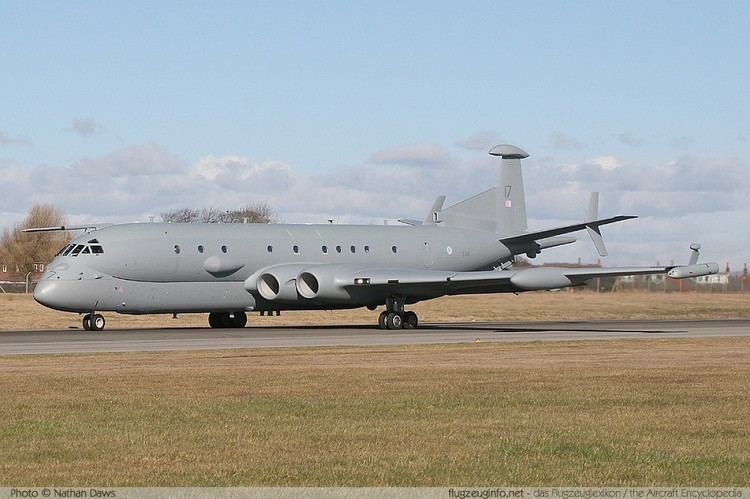 | ||
Bae systems nimrod mra4 fairford 2007
The BAE Systems Nimrod MRA4 was a planned maritime patrol and attack aircraft intended to replace the Hawker Siddeley Nimrod MR2. The rebuilt aircraft would have extended the operating life of the Nimrod fleet by several decades and significantly improved the aircraft by installing more efficient Rolls-Royce BR700 turbofan jet engines to almost double the flight range. The conversion of the flight deck to a digital glass cockpit would have simplified control operations and reduced crew requirements. New detection systems were to be installed, as well as additional weapons for anti-submarine warfare.
Contents
- Bae systems nimrod mra4 fairford 2007
- Bae systems nimrod mra4 at riat 2009
- Origins
- Selection
- Delays and development problems
- Cancellation
- Replacement
- Specifications MRA4
- References

However the project was subject to significant delays due to cost over-runs and contract re-negotiations. This was partly due to difficulties combining refurbished Nimrod MR2 fuselages, which had not been built to a common standard, with newly built wings. The numbers of aircraft to be procured fell from 21 to nine over a course of years, while costs continued to climb.
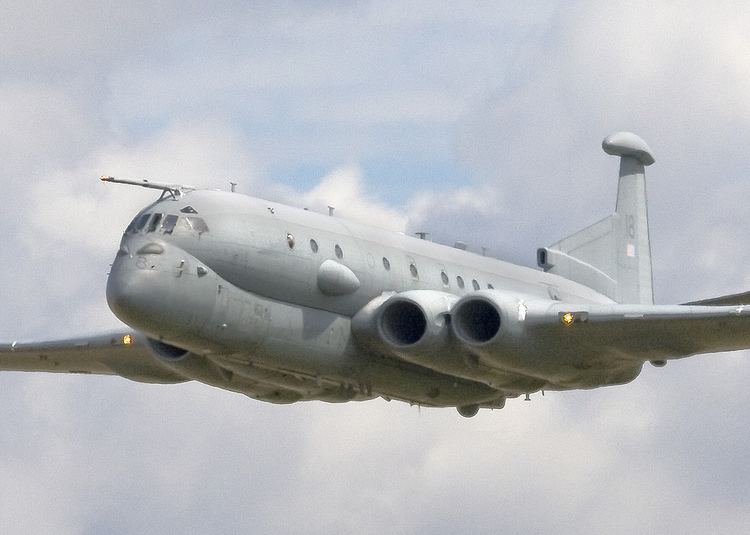
The MRA4 was ultimately cancelled in 2010 as a result of the Strategic Defence and Security Review, at which point it was £789 million over-budget and over nine years late. There is no direct replacement under development. The roles intended for the MRA4 are filled by existing assets such as the Type 23 Frigate and the Merlin helicopter. On 23 November 2015, the UK announced its intention to order nine P-8 Poseidon ASW aircraft as part of the Strategic Defence and Security Review 2015, effectively replacing the Nimrod.
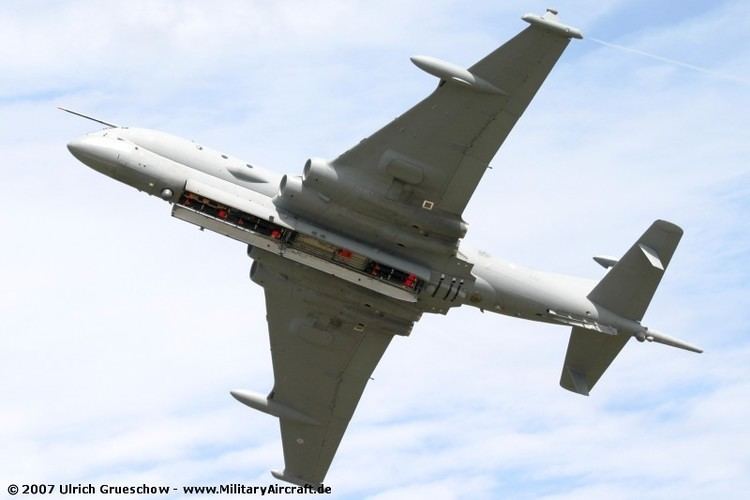
Bae systems nimrod mra4 at riat 2009
Origins

In 1988, the Royal Air Force (RAF) commenced a Replacement Maritime Patrol Aircraft (RMPA) procurement programme, also known as Staff Requirement (Air) 420, which was intended to replace their fleet of Nimrod MR2 aircraft. Alternative options, such as avionics, sensors and tactical system upgrades of the MR2, were abandoned in 1990. In 1993, a formal request for information was released. In response to the requirement, several different companies soon submitted their bids to meet the outlined demands. British Aerospace, who had internally studied prospective options to replace the Nimrod MR2 since 1986, including a variant of the Airbus A310 and other civil conversion projects, ultimately settled on a proposal that involved an extensive rebuild of several of the existing Nimrod MR2s. The remanufactured aircraft, which was marketed under the name Nimrod 2000, involved several major changes being performed, including the adoption of new engines, avionics, and mission systems.
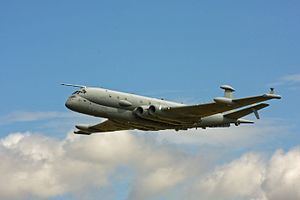
Early on, British Aerospace had evaluated several different engines to power the Nimrod 2000 early on, such as the Rolls-Royce Tay turbofan and Pratt & Whitney JT8D-200 turbojet engines, before settling upon the Rolls-Royce BR710 engine. In 1995, it was claimed that the Nimrod MR2 airframes were of a sufficient condition in that they could readily serve through the intended 25 year service life and that "retained airframe items are low risk". According to British Aerospace, the Nimrod's airframe represented "probably the best understood airframe in the RAF inventory".
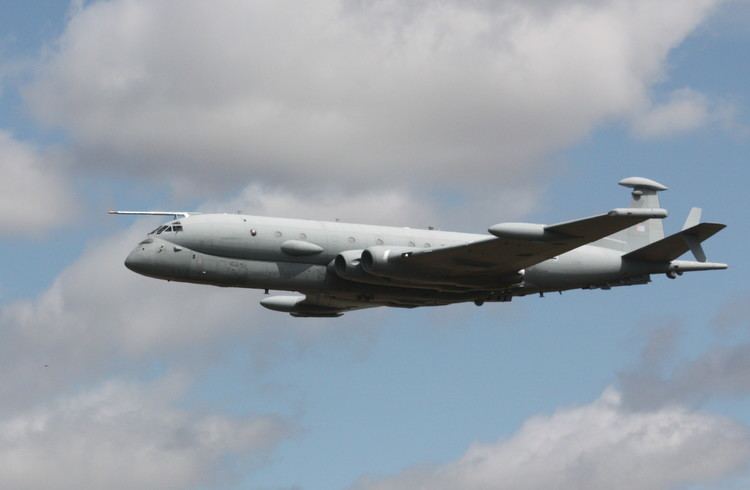
Amongst various other bids submitted were Lockheed Corporation, who marketed its P-3 Orion as the Orion 2000, Loral Corporation proposed to rebuild ex-US Navy Orions, and Dassault who sought to develop the improved Atlantique 3. On 12 January 1996, Dassault announced that they had withdrawn their Atlantique 3 offer following discussions held with the MOD; Whitehall sources stated that Dassault had found "...no value in perusing its tender", and that the RAF had an expressed preference for a four-engine aircraft. In early 1996, Loral's defense assets were acquired by Lockheed, leading to the competition thinning down to only two remaining companies, Lockheed and British Aerospace, by mid-1996.
In March 1996, British Aerospace promoted the option of establishing a production line to manufacture new-build Nimrod MRA4 aircraft as an alternative to the refurbishment of existing airframes, this was reportedly motivated by service concerns regarding attrition rates of the existing aircraft. It was also announced that preliminary talks had been conducted with the South African Air Force on the topic of the Nimrod 2000; British Aerospace were also considering the merits of using a newly developed variant of the General Electric CF34 turbofan powerplant, which General Electric had formally proposed the specific use of to power the type. In June 1996, British Aerospace announced that it had partnered with McDonnell Douglas to market new-build Nimrod 2000s to the export market; it has been claimed that this move was in response to scepticism from the MoD over the prospects of export sales for the type. British Aerospace argued that the Nimrod 2000's selection would give it entry to the global maritime patrol aircraft market.
As part of Lockheed's submission, the firm offered a formal guarantee of a 20 per cent workshare on all future export sales of its Orion 2000 while simultaneously lobbying for the United States Navy to also procure the type. Loral stated that it believed that its bid to refurbish stored P-3s was the most cost-effective submission; however, there was public controversy over whether Loral possessed the necessary technical information on the airframe, claims to which Loral strongly refuted. In May 1996, it was reported that bidders were considering self-funding their own early development costs in order to compensate for alleged funding shortfalls within the MoD's procurement budget; it was claimed that these funding shortfalls were due to differences between the original specification, which had envisioned as an off-the-shelf procurement without much in terms of development, and the increasingly extensive nature that the programme had progressively taken on.
Selection
In June 1996, the MoD's Equipment Approvals Committee issued its recommendation that the Nimrod 2000 bid be selected to meet the RAF's requirement. In July 1996, in response to the committee's decision, Lockheed Martin announced that it had reduced the cost of its Orion 2000 submission by 15 per cent amid a series of last-minute discussions held between Lockheed Martin President Norman R. Augustine, General Electric Company (GEC) Lord Weinstock, Secretary of State for Defence Michael Portillo, and Deputy Prime Minister Michael Heseltine, seeking a 90-day interval to fully revise their bid. In December 1996, it was announced that the $US3.5-billion contract had been awarded to British Aerospace to produce the Nimrod 2000, at which point the aircraft had also received the designation Nimrod MRA4.
As selected, the Nimrod MRA4 was to be produced as essentially a new aircraft. Significant changes were involved in the remanufacturing process, including the installation of current-generation BR710 turbofan engines, the adoption of a larger and more efficient wing, various new missions systems and avionics, and an extensively refurbished fuselage. Much larger air intakes were required on the MRA4 in order to provide the necessary airflow requirements imposed by the BR710 engine, which are significantly greater than that of the original Spey 250 that had powered the original Nimrod variants. The MRA4 had also borrowed heavily from Airbus technology; the glass cockpit used was derived from the Airbus A340 airliner. British Aerospace also teamed up with Boeing to provide the Nimrod MRA4's mission systems, making use of the later's work on mooted patrol aircraft systems for the P-3 and Boeing 737.
According to BAE Systems, the Nimrod MRA4 systems was to enable the crews to gather, process and display up to 20 times more technical and strategic data than the MR2. The Searchwater 2000 radar was stated to have been capable over land as well as water; with the ability to have swept an area the size of the UK every 10 seconds. The Aircraft Synthetic Training Aids (ASTA) provided by Thales Training & Simulation was an electronic training suite to allow the training of crew members to transfer from active MRA4 aircraft to ground-based training systems; this change was made to increase the availability of the aircraft for operational missions and allow for more intensive training exercises.
Delays and development problems
The original scheduled date of entry into service for the MRA4 was April 2003; however, development proved far more protracted than anticipated. Early on, an independent company, Flight Refuelling Ltd., had been contracted to undertake the conversions to MRA4 standard, however BAE discovered that the Nimrod airframes supplied by the RAF were not built to a common standard and this considerably complicated the refurbishment process. The task of converting the existing airframes was transferred in-house to BAE Systems Woodford. The BAE team at Woodford then found that the new wing was flawed, which resulted in the project being put on hold while another wing design was developed.
In December 2002, BAE Systems issued a shock profit warning due to cost overruns of the Nimrod MRA4 and the Astute class submarine projects. On 19 February 2003, BAE took a charge of £500 million against the MRA4 contract. The company had previously taken a £300 million "loss charge" in 2000, which was expected to cover "all the costs of completion of the current contract". The contract was renegotiated for the second time in 2002, where the aircraft requirement was reduced from 21 to 18.
Announcing plans for the future of the British military on 21 July 2004, the Defence Secretary Geoff Hoon detailed plans to reduce the upgrade programme to cover only 16 MRA4 aircraft, and suggested that an eventual fleet of 12 might suffice. PA02, the second development MRA4, achieved its first flight in December 2004 and was used to test elements of the mission system and the air vehicle. BAE Systems received a contract worth £1.1 billion for 12 MRA4s on 18 July 2006; three were to be development aircraft and nine more converted to production standard. The Nimrod MRA4 successfully released the Sting Ray torpedo for the first time on 30 July 2007.
Further disputes over cost meant that the number of MRA4s to be delivered was further reduced to nine by Spring 2008. The first production aircraft took its maiden flight on 10 September 2009. At the time of the flight, each MRA4 was to cost at least £400 million. The Ministry of Defence announced in December 2009 that the introduction of the MRA4 would be delayed until 2012 as part of defence spending cuts. In March 2010, the first production Nimrod MRA4 was delivered to the RAF for acceptance testing; in August 2010, the RAF launched its instructor training course using the type. The MRA4 fleet was expected to attain initial operational capability in October 2012. The Nimrod MRA4 was planned to operate out from its main base at RAF Kinloss, Scotland.
Cancellation
In the 2010 Strategic Defence and Security Review of the Armed Forces, the UK government announced the cancellation of the MRA4 on 19 October 2010 and consequently that RAF Kinloss, the intended base for the Nimrod fleet, would be closed. On 24 November 2010, 382 sub-contract workers previously working on the MRA4 were laid off at BAE Systems Warton and Woodford. After the airframes were stripped of electronic equipment, the remaining fuselages were scrapped at BAE Systems Woodford beginning on 26 January 2011. Although the process was conducted behind screens intended to hide the process from the media, the BBC flew a helicopter over Woodford and broadcast footage of the scrapping in process.
Although late and over-budget the decision to cancel the MRA4 was controversial as the remaining airframes had all been near completion. It has been reported that following the retirement of the Nimrod MR2 (in March 2010.), Russian submarines have been able to travel past the UK in international waters, but they could not be tracked because of the lack of suitable aircraft. In November and early December 2014 four maritime patrol aircraft operated by France, Canada and the United States were based at RAF Lossiemouth to attempt to locate a Russian submarine which had been spotted in British territorial waters off west Scotland.
The aircraft would also have been used in the civilian search and rescue role, the Nimrod MR2 had often been used in this role. In this respect the Strategic Defence and Security Review stated that the UK "will depend on other maritime assets to contribute to the tasks previously planned for [the Nimrod MRA4]".
Following the cancellation, the Defence Secretary Liam Fox used the Nimrod MRA4 procurement as an example of the worst of MOD procurement performance: "The idea that we ever allow ourselves into a position where something that was originally Nimrod 2000 – where we ordered [21] was reduced to nine, spent £3.8bn and we still weren't close to getting the capability – is not to happen again." Nevertheless, six ex-defence chiefs publicly criticised the decision to scrap the Nimrods in January 2011 and the Public Accounts Committee concluded in February 2012 that the decision had been made without a proper understanding of the cost implications and had wasted £3.4bn.
In January 2011 it was reported by the Financial Times that when the decision was taken to scrap the aircraft, "[The MRA4] was still riddled with flaws.... Safety tests conducted [in 2010] found there were still 'several hundred design non-compliances' with the aircraft. It was unclear, for example, whether its bomb bay doors functioned properly, whether its landing gear worked and, most worryingly, whether its fuel pipe was safe." According to Air Forces Monthly magazine, "significant aerodynamic issues and associated flying control concerns in certain regimes of flight meant that it was grounded at the time of cancellation and may not have been signed over as safe by the Military Aviation Authority." The magazine also stated that the reason for the cancellation was that the RAF and Navy placed a higher priority on fast jets and frigates than on maritime patrol.
Replacement
Reports in mid-2011 suggested that a purchase of up to five P-8 Poseidons was under consideration, while in January 2015 it was reported that attempts had been made to sell the Kawasaki P-1 as another possible replacement. In November 2015, as part of the Strategic Defence and Security Review, the Ministry of Defence announced the procurement of nine P-8 Poseidons, which will undertake the range of tasks that were undertaken by the Nimrod MR.2 and intended for the MRA.4.
Specifications (MRA4)
Data from Flight Insight, armedforces.co.uk
General characteristics
Performance
Armament
Avionics
